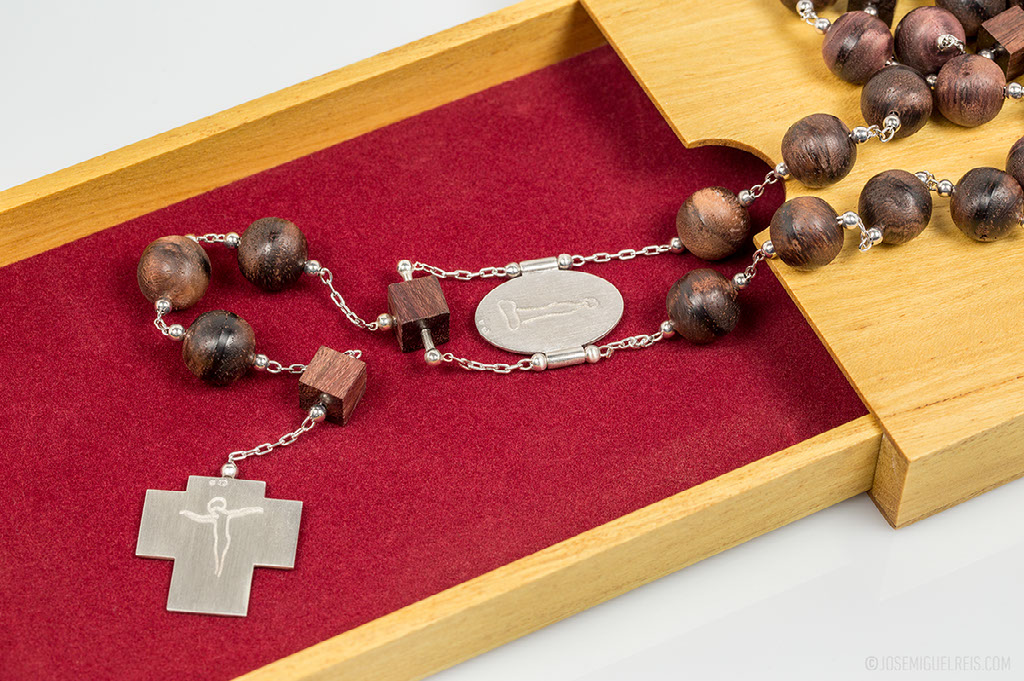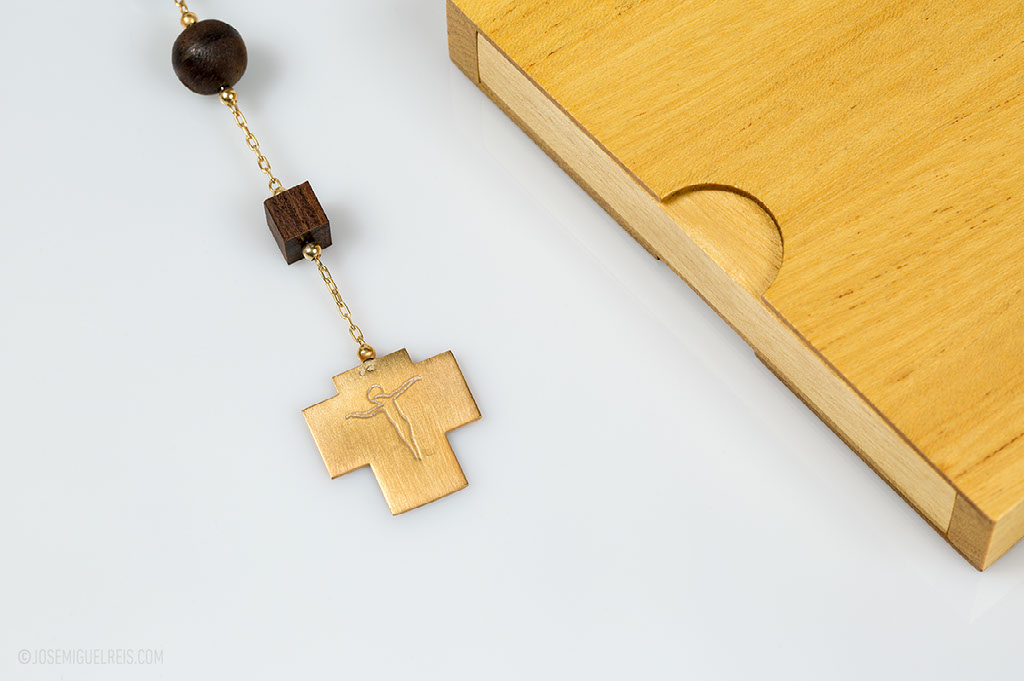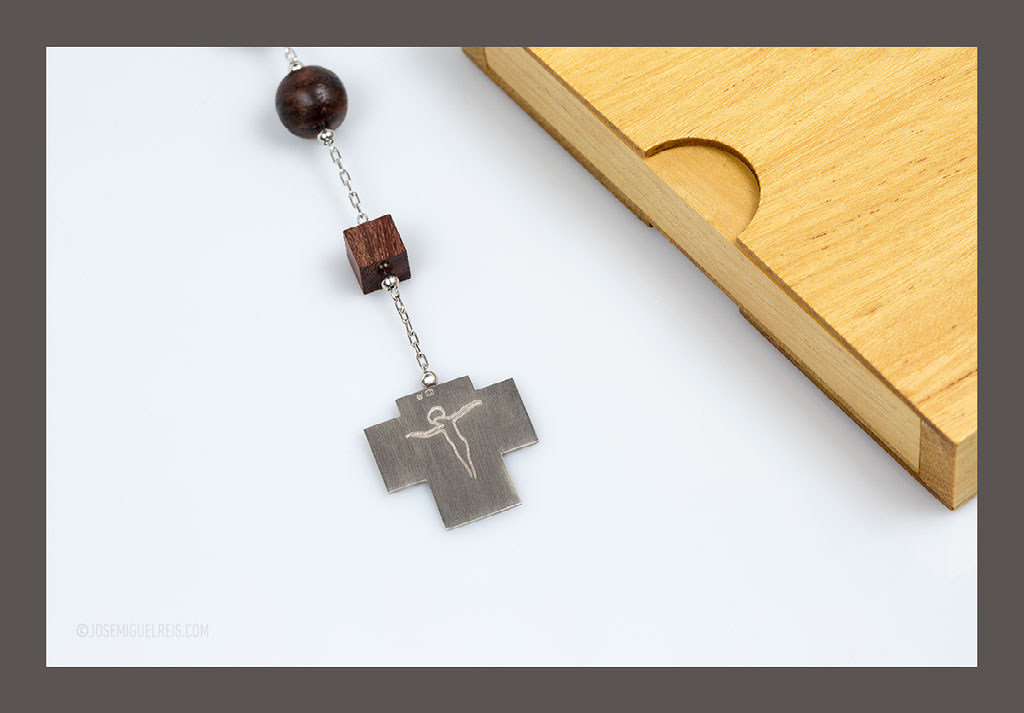Terço de Álvaro Siza THE ROSARY OF ÁLVARO SIZA
TERÇO DE ÁLVARO SIZA NO CENTENÁRIO DAS APARIÇÕES DE FÁTIMA / THE ROSARY OF ÁLVARO SIZA ON THE CENTENARY OF THE APPARITIONS OF FÁTIMA [1917-2017]
‘O Rosário ou saltério da Virgem Maria é um modo de oração ou súplica a Deus, um modo fácil e ao alcance de todos, que consiste em louvar a Virgem Maria repetindo a saudação evangélica da Anunciação 150 vezes, que é o número de salmos do saltério de David, intercalando entre cada dezena a oração do Senhor (Pai-nosso) e algumas meditações que se referem à vida e mistério de Jesus Cristo’ (Pio V, 1566-1572)
‘The Rosary or Psalter of the Blessed Virgin Mary is a way of praying or plea to God, an easy way and within the reach of everyone, consisting in praising the Virgin Mary by repeating the evangelic salutation of Annunciation 150 times, which is the number of psalms of David’s psalter, and including, every ten times, the Lord’s Prayer (Our Father) and some meditations referring to the life and mystery of Jesus Christ” (Pius V, 1566-1572).

A história do Rosário desenvolve-se entre os séculos XII e XVI. No começo do século XII difundiu-se no ocidente o costume da recitação da Ave Maria. A saudação do anjo já era conhecida da cristandade, pois faz parte dos evangelhos, e era usada em antífonas litúrgicas. Mas a sua repetição litânica, à semelhança do saltério de David, desenvolve-se nesta altura nos mosteiros, destinada sobretudo aos monges que não sabiam ler. O Ave Maria era recitado apenas na sua primeira parte evangélica, contendo a saudação do Anjo (‘Ave Maria, cheia de graça, o Senhor está contigo’ – Lc 1, 28) e a bênção de Isabel (‘Bendita és tu entre as mulheres e bendito é o fruto do teu ventre’ – Lc 1, 42). O nome de Jesus e o Amen final foi introduzido em finais do século XV quando se começou a acrescentar também a ‘Santa Maria’. Mas já antes, na primeira metade do século XV, Domingos da Prússia, cartuxo de Colónia, propôs aos fiéis uma redução para 50 Ave Marias (um terço do Rosário) e em cada uma delas se fazia uma referência verbal explícita a um facto evangélico relacionada com a vida pública ou oculta de Jesus.
The history of the Rosary takes place between the 12th and 16th centuries. In the beginning of the 12th century, the tradition of reciting the Hail Mary was spread throughout Western Europe. The Angel’s Annunciation (or Salutation) was already known to the Christendom, since it is part of the gospels and was used in liturgical antiphonies. But its litany repetition, similarly to David’s psalter, was developed in monasteries, aiming mainly at illiterate monks. Only the first evangelic part of the Hail Mary was recited, including the Angel’s Annunciation (“Mother of God and Virgin, rejoice, Mary full of grace, the Lord is with thee” – Lk 1-28) and Elizabeth’s Blessing (“Blessed are you among women, and blessed is the child you will bear” – Lk 1-42). The name of Jesus and the final Amen were introduced in the late 15th century, when “St. Mary” also began being added. But before that, in the first half of the 15th century, Dominic of Prussia, a Carthusian monk of Cologne (Germany), suggested to its congregation a reduction to 50 Hail Marys (a third of the Rosary) and, in each Rosary1, the inclusion of an explicit verbal reference to an evangelic fact related to the public or hidden life of Jesus.

A história do Rosário (e do Terço) tem, portanto, uma longa e complexa história. Um dos momentos importantes dessa divulgação tem a ver com as aparições de Fátima de 1917. Em todas as aparições Nossa Senhora pede aos pastorinhos para rezarem o Terço todos os dias.
Therefore, the history of the Rosary and its shorter variation have a long and complex narrative. One of the most important moments of that dissemination is related to the apparitions of Fatima, in 1917. In every single one of the apparitions, the Blessed Virgin asked the shepherd children to pray the Rosary every day.
Poucos acontecimentos tiveram na história recente de Portugal um impacto social e religioso tão forte como as aparições de Fátima. Poucos objectos se identificam tão clara e imediatamente com esse acontecimento como o Terço. Poucos artistas assumem uma densidade cultural tão forte como Álvaro Siza, quer em Portugal quer no mundo.
Few events in Portugal’s recent history had such a social and religious impact as the apparitions of Fátima did. Few objects are as clearly and immediately connected to that event as the Rosary. Few artists assume such a strong and dense cultural density as Alvaro Siza, either in Portugal or worldwide.

Com esta edição do Terço a Letras e Coisas associa este acontecimento (centenário das aparições), este objecto (Terço) e este artista (Álvaro Siza) num momento único de celebração e numa peça de devoção para a história.
With this edition of the Rosary, Letras e Coisas associates this event (the centenary of the apparitions), this object (the Rosary), and this artist (Álvaro Siza), in a unique moment of celebration and in a historical piece of devotion.
Ideia Original: Nuno Higino • Desenho do Terço e da caixa: Arq. Álvaro Siza • Edição: LetraseCoisas.pt Produção (Alcino Joalheiros) • Concepção Gráfica e Fotografia: www.Josemiguelreis.com • Ano: 2016